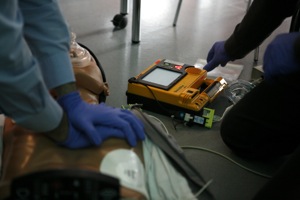
Basic Life Support
last authored: April 2010, David LaPierre
last reviewed:
Introduction

CPR with AED simulation
courtesy of Rama, wikipedia
Basic life support (BLS) is the provision of care to an unresponsive patient. The mainstay of BLS is cardiopulmonary recuscitation, or CPR. Immediate bystander CPR given to a witnessed cardiac arrest doubles the chances of survival.
Primary Survey
When approaching an unresponsive victim, ensure you are not placing yourself, or others, in further danger, by evaluating scene safety.
Consider the mechanism of injury, especially in regards to the possibility of cervical spine fracture.
Check responsiveness: tap the patient and speak loudly into each ear: "Are you ok? Are you alright?"
If the patient is unresponsive, ask someone to:
- activate emergency response (ie 911)
- get AED
If there are no bystanders, send for help, and retrieve an AED, yourself.
CAB
While for many years teaching was ABC - airway, breathing, circulation - in 2010, the American Heart Association published new guidelines for approaching an unresponsive patient, with the order now being CAB - circulation, airway, and breathing.
- circulation
- airway
- breathing
- defibrillation
Circulation
Feel for a carotid pulse for 5-10 seconds. If no pulse is present, remove clothing to expose chest.
If you do not definitely feel a pulse after 10 seconds, begin CPR. Push hard and fast, at a rate of 100 compressions per minute. Ensure compression of 1.5-2 inches in adults, with full chest recoil.
For children and infants, compress at least 1/3 of the chest.
- 2 inches/5 cm in children
- x inches/x 5m in infants
PLace the base of the bottom hand above the sternum. Keep elbows straight, and shoulders above the sternum.
Given cycles of 30 compressions and two breaths until an AED arrives. Minimize breaks between CPR; the two breaths should be given in ten seconds or less. Every time these is a pause, coronary perfusion drops significantly.
During CPR, duing pulse/rhythm checks every 2 minutes, or 5 cycles of CPR. The person doing compressions should count these, if time keepers are not present. One helpful way to remember the number of cycles is to look at the patient's arm, leg, leg, other arm, and then head during a given cycle.
Resume CPR immediately after shock. New spontaneous heart rhythms tend to be slow and inadequate for perfusion, necessitating CPR for several minutes until adequate heart function resumes.
Airway
Airway management is the process of ensuring that
- there is an open pathway between a patient’s lungs and the outside world
- the lungs are safe from aspiration
to ensure adequate ventilation and maintain the life of the patient.
In nearly all circumstances, airway management is the highest priority for clinical care, and should be the first step in all clinical assessment. This is because if there is no airway, there can be no breathing, hence no oxygenation of blood and therefore circulation (and hence all the other vital body processes) will soon cease. Getting oxygen to the lungs is the first step in almost all clinical treatments. The ‘A’ is for ‘airway’ in the ‘ABC’ of cardiopulmonary resuscitation.
securing the airway is described under basic airway management.
Breathing
If there is no breathing, give two breaths. A breath should take one second, and a rise in the chest should be visible.
Options include:
- mouth-to-mouth
- mouth-to-nose
- mouth to barrier device
- bag-valve mask
If unable to ventilate, re-position with head-tilt, chin-lift, or jaw thrust. If ventilation is still insufficient, proceed to chest compressions.
Information regarding bag-valve-mask is provided under basic airways.
Defibrillation
If there is no pulse, attach an AED or a manual defibrilator.
2-4 J/kg for children. For refractory VF, the dose should be 4-10 J/kg.
BLS for Children
Children ages 1 -puberty
use lower volume of air.
Perform 5 cycles of chest compressions before seeking help. However, if arrest is witnessed, activate emergency reponse and seek an AED before beginning chest compressions.
Compress to depth of 1/3 - 1/2 chest depth, with 30 compressions : 2 rescue breaths. If two rescuers are present, the ratio is 15 compressions : 2 breaths up to the age of puberty; at this point, the ratio increases to
BLS for Infants
CPR is the same for infants, with some differences. Palpate the brachial pulse.
Single rescuer: Use two fingers, placed just below the nipple line. Compress the chest 1/3 to 1/2 the chest depth. Ensure a solid surface below the infant. Give 30 compressions for every 2 breaths.
Two rescuers: wrap two hands around chest, with thumbs placed centrally. Do 15 compressions for every two breaths. Switch roles every five cycles.
CPR with Advanced Airway
There are a variety of artificial airways which can be used to keep a pathway between the lungs and mouth/nose.
Once an advanced airway (endotrachial tube, laryngeal mask airway, Combitube) is in place, one rescuer should continue compressions at 100 per minute, while the other rescuer provides one breath every 6-8 seconds. There is no need to pause for ventilations.
Change roles, quickly, every two minutes to prevent fatigue.
In the case of a choking patient, laryngoscopy or even bronchoscopy may be performed in order to visualise and remove the blockage.
Recovery Position
The recovery position is used in out-of-hospital settings, where sufficient equipment to support the airway is not available. Once the patient has regained spontaneous breathing and circulation, they should be placed on their side with the top leg bent.
Additional Resources
2005 American Heart Association CPR adult guidelines
2005 American Heart Association CPR pediatric guidelines
